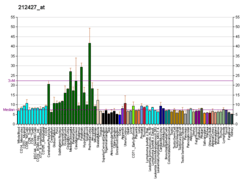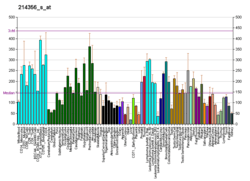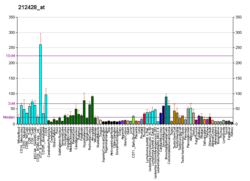KIAA0368
| KIAA0368 | |||||||
|---|---|---|---|---|---|---|---|
| Identifiers | |||||||
| Aliases | KIAA0368, ECM29 | ||||||
| External IDs | MGI: 2140220 HomoloGene: 6056 GeneCards: KIAA0368 | ||||||
| RNA expression pattern | |||||||
   | |||||||
| More reference expression data | |||||||
| Orthologs | |||||||
| Species | Human | Mouse | |||||
| Entrez | |||||||
| Ensembl | |||||||
| UniProt | |||||||
| RefSeq (mRNA) | |||||||
| RefSeq (protein) | |||||||
| Location (UCSC) | Chr 9: 111.36 – 111.48 Mb | Chr 4: 58.8 – 58.91 Mb | |||||
| PubMed search | [1] | [2] | |||||
| Wikidata | |||||||
| |||||||
Proteasome-associated protein ECM29 homolog is a protein that in humans is encoded by the KIAA0368 gene.[3][4][5]
References
- ↑ "Human PubMed Reference:".
- ↑ "Mouse PubMed Reference:".
- ↑ Nagase T, Ishikawa K, Nakajima D, Ohira M, Seki N, Miyajima N, Tanaka A, Kotani H, Nomura N, Ohara O (Sep 1997). "Prediction of the coding sequences of unidentified human genes. VII. The complete sequences of 100 new cDNA clones from brain which can code for large proteins in vitro". DNA Res. 4 (2): 141–50. PMID 9205841. doi:10.1093/dnares/4.2.141.
- ↑ Gorbea C, Goellner GM, Teter K, Holmes RK, Rechsteiner M (Dec 2004). "Characterization of mammalian Ecm29, a 26 S proteasome-associated protein that localizes to the nucleus and membrane vesicles". J Biol Chem. 279 (52): 54849–61. PMID 15496406. doi:10.1074/jbc.M410444200.
- ↑ "Entrez Gene: KIAA0368 KIAA0368".
Further reading
- Andersson B, Wentland MA, Ricafrente JY, et al. (1996). "A "double adaptor" method for improved shotgun library construction.". Anal. Biochem. 236 (1): 107–13. PMID 8619474. doi:10.1006/abio.1996.0138.
- Yu W, Andersson B, Worley KC, et al. (1997). "Large-Scale Concatenation cDNA Sequencing". Genome Res. 7 (4): 353–8. PMC 139146
 . PMID 9110174. doi:10.1101/gr.7.4.353.
. PMID 9110174. doi:10.1101/gr.7.4.353. - Strausberg RL, Feingold EA, Grouse LH, et al. (2003). "Generation and initial analysis of more than 15,000 full-length human and mouse cDNA sequences". Proc. Natl. Acad. Sci. U.S.A. 99 (26): 16899–903. PMC 139241
 . PMID 12477932. doi:10.1073/pnas.242603899.
. PMID 12477932. doi:10.1073/pnas.242603899. - Ota T, Suzuki Y, Nishikawa T, et al. (2004). "Complete sequencing and characterization of 21,243 full-length human cDNAs". Nat. Genet. 36 (1): 40–5. PMID 14702039. doi:10.1038/ng1285.
- Bouwmeester T, Bauch A, Ruffner H, et al. (2004). "A physical and functional map of the human TNF-alpha/NF-kappa B signal transduction pathway". Nat. Cell Biol. 6 (2): 97–105. PMID 14743216. doi:10.1038/ncb1086.
- Humphray SJ, Oliver K, Hunt AR, et al. (2004). "DNA sequence and analysis of human chromosome 9". Nature. 429 (6990): 369–74. PMC 2734081
 . PMID 15164053. doi:10.1038/nature02465.
. PMID 15164053. doi:10.1038/nature02465. - Beausoleil SA, Jedrychowski M, Schwartz D, et al. (2004). "Large-scale characterization of HeLa cell nuclear phosphoproteins". Proc. Natl. Acad. Sci. U.S.A. 101 (33): 12130–5. PMC 514446
 . PMID 15302935. doi:10.1073/pnas.0404720101.
. PMID 15302935. doi:10.1073/pnas.0404720101. - Gerhard DS, Wagner L, Feingold EA, et al. (2004). "The Status, Quality, and Expansion of the NIH Full-Length cDNA Project: The Mammalian Gene Collection (MGC)". Genome Res. 14 (10B): 2121–7. PMC 528928
 . PMID 15489334. doi:10.1101/gr.2596504.
. PMID 15489334. doi:10.1101/gr.2596504. - Rual JF, Venkatesan K, Hao T, et al. (2005). "Towards a proteome-scale map of the human protein-protein interaction network". Nature. 437 (7062): 1173–8. PMID 16189514. doi:10.1038/nature04209.
- Ewing RM, Chu P, Elisma F, et al. (2007). "Large-scale mapping of human protein–protein interactions by mass spectrometry". Mol. Syst. Biol. 3 (1): 89. PMC 1847948
 . PMID 17353931. doi:10.1038/msb4100134.
. PMID 17353931. doi:10.1038/msb4100134.
This article is issued from
Wikipedia.
The text is licensed under Creative Commons - Attribution - Sharealike.
Additional terms may apply for the media files.